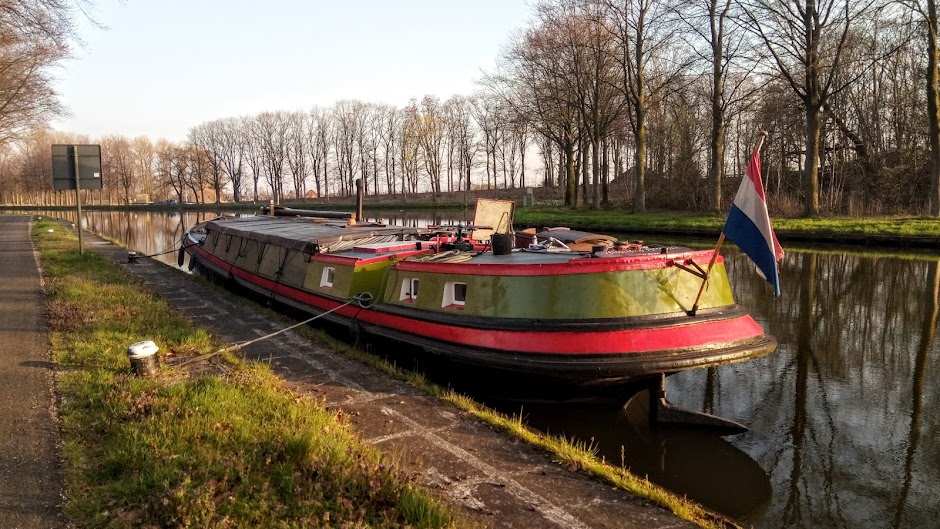Nearly three years ago, Mo and and her husband bought their gorgeous little
tjalk, the Marion Aagje. I'd seen the advertisement for it on a local 'e-bay' type site. It looked lonely and neglected at its mooring in Diemen, near Amsterdam and very much in need of some TLC. Since then, my daughter and sin-in-law have lovingly converted it into their home and lavished care, hard work and an awful lot of paint on it. Now it lies proud and serene in a harbour here in Rotterdam.
During all this time, Mo has been trying to find out more about its history. At first, this was because they wanted to restore it, and to get a restoration place here in the Oude Haven where I have the Vereeniging. However, to do this you have to have a restoration plan meaning you have to know what your ship's conformation was originally. Sadly, in spite of all Mo's skills as a researcher, the information constantly evaded them and they were unable to get a place here, so they eventually settled for not restoring the ship, but for maintaining it as it was and keeping it in a commercial harbour across the river.
Mo kept on looking, though. The little ship sort of begged for it. And then a few weeks back, she found a reference to a book written by a descendent of the Muller family who used to own the Marion Aagje. It claimed to be about the barges and boats this family - a huge tugboat business now - had owned. So without really thinking, she ordered the book and then forgot about it.
Some days ago now, I picked up a parcel for her from the post, and also forgot about it. I assumed it was a study book and as we were all on holiday, it didn't seem that important, but then two days ago, Mo dropped in for coffee and I remembered the parcel. Mo opened it to find the most beautiful volume filled with illustrations, maps and photographs of the Muller family's
binnenvaart history. In some excitement, we turned to the index page to look for the name of their ship. It was there, but not quite as we'd expected. The Marion Aagje was actually called the Maria Aagje. And this was - or had been the problem all along. Two small letters in its name. The intrusive 'n', as linguistic specialists would call it, probably the result of verbal misinterpretation somewhere along the way, ensured that the legal records were accidentally changed.
With this book, the floodgates of information have opened and we are now learning more and more about the exciting and sometimes swashbuckling adventures of Mo's little barge. It was the smallest sea-going sailing barge in the Netherlands in its time, and there is a lovely story about how a skipper overlooked it in the harbour where it now lies because he was looking for a
zeeschip of much larger proportions. Because of its rounded hull, it was also very fast and even won races over other, larger
tjalken.
The Maria Aagje's skipper, Janus Muller, was apparently a real rogue of a character who broke laws, managed to sink the barge at one time, hid it during the war and got himself arrested for carrying illegal goods. In true piratical tradition, he even wore rags around his head and succeeded in shooting his own eye out accidentally. The little barge ploughed the seas from Zeeuws Vlaanderen to Denmark and only after around seventy five years of loyal service to the Muller family did they finally part with it in the 1950s.
Since discovering its real name Koos has posted it on a special website for people with an interest in
tjalken and still more details are flowing in. It's been exciting, emotional and exhilarating, and all the more so because Mo has recently decided to sell the ship in favour of living on land. The effort is now on to find a buyer worthy of this barge with so much experience, so many stories and so much history. We all feel quite strongly it has to go to someone who will care for and do it justice. After all, now it has come to life again, it cannot simply be allowed to sink into oblivion, can it?
A few more interesting facts that tie this little barge to us all:
1. It is known to have spent time in the
Binnenhaven in Rotterdam where Mo and Craig now have their mooring
2. Its first owner, Simon Muller was born in 1855, a hundred years before my birth and died in 1948, the year of Koos's birth.
3. The family Muller own a very large tugboat business, based in Dordrecht and seen daily on the waterways here in Rotterdam.
4. The Maria Aagje is noted as having been in Terneuzen, the closest sea port and just a few kilometres from our home in Zeeuws Vlaanderen.
It's no wonder we have always felt this barge was special, so now we know what's in its name.












